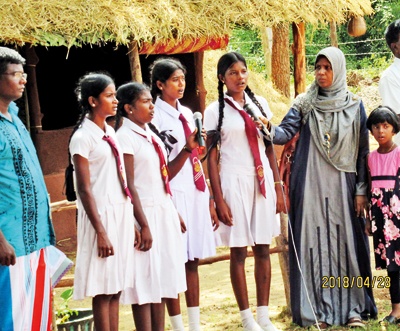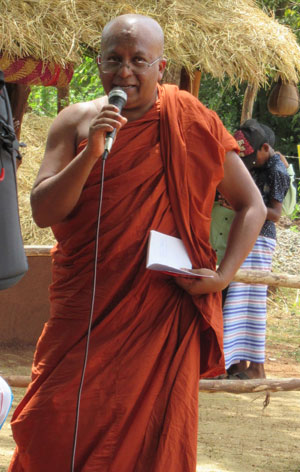In a remote village, Avurudu comes alive in the true spirit of reconciliation

Singing the National Anthem both in Sinhala and Tamil
The Sinhala and Tamil New Year is clearly an ideal opportunity for both communities to join and celebrate and promote peace and reconciliation. It is a time to forget the past and look towards a better future.
Halmillvatiya is 10 km north east of Kebithigollewa, a border village which suffered during the civil war. Therankandal in Mallavi is 30 kms south west of Kilinochchi, the former capital of the LTTE.
Ven. Galkande Dammanada Thera, Director of the Walpola Rahula Institute had motivated the students of the Halmillvatiya Vidyalaya, to visit the Therankandal Government Tamil Mixed School in January 2018 for Thai Pongal.
On Saturday, April 28, the students, parents and teachers of Therankandal School visited the Halmillvatiya Vidyalaya. A few of us were also invited to attend this reciprocal function. Leaving Colombo at 4 a.m. we reached Halmillvatiya by 10, in time to listen to the National Anthem sung in both Sinhala andTamil at the start of event.All of the proceedings were simultaneously translated to Tamil by Lareena Abdul Haq, a lecturer in Tamil language at the Sabaragamuva University. The traditional oil lamp which was lit, was placed on a small tree. After the welcome speeches by the Principal and Ven.Dammanada Thera, there were many cultural performances by students and staff of both schools. The Kaveri Kala Manram, sent by Rev. Joshua Sivanganam of Malayalapuram also performed.
Interspaced was a presentation of the traditional Avurudu customs, enacted in a mud hut built for the occasion. After a tea break of delicious kiribath, kavum and kokis, the Avurudu games began with active participation of students from both schools. There were even events for the accompanying adults. After a sumptuous late lunch the proceedings wound up. The students of the Tamil school needed to travel 100 kms to get back before dark.
It was a fabulous event smoothly organized – the type of event which needs to be replicated whenever possible to promote friendship and collaboration between the communities.
The Sinhala schools are interested in teaching Tamil and the Tamil school in teaching Sinhala, but the process is hampered by the lack of teachers. The schools are exploring the possibility of video interaction, if a stable Internet connection could be established for online education. This would clearly help expand interaction between the schools.
The HalmillvatiyaVidyalaya is adjoining Kalagam Vehera which is a site with a huge Asanagara (stone slab popularly known as a gal adha), The site has been restored after the end of the civil war.
A Bodhigara in front of the Asanagara, had been excavated to a depth of nine feet and showed rare evidence of the ancient Bo-tree. It had been filled up with sand for protection, as a glass cover which would have been ideal, was considered too expensive. A stone inscription of King Kassapa IV (898-914 CE) found on site proclaimed that Officers may not enter the precincts of KalagamVehera on matters of state, and cart oxen, buffaloes and elephants were not permitted within its boundaries.

Ven. Galkande Dammanada Thera
A few kms further along the road is the Sinhaya Ulpatha – a perennial natural spring which is used to obtain clean water for drinking and cooking. Unfortunately the ancient stone lion face had been destroyed in the mid 1990’s by vandals who had crushed it in a futile search for treasure.
Halfway back towards Kebithigollewa is the Halmillewa Sulugal DambuluViharaya, an image of which was used on the recent modified Rs 1000 note issued for independence. The identification had been given to me by artist Kelum Gunasekara, who wanted to use a less known popular site. It is built on the side of a cave with Brahmi letters stating it was a gift to the Sangha.The associated Devale, has a rare wooden statue of Vishnu estimated to be about a 1000 years old.
This attracts devotes from all parts of Lanka.Particularly those who are pregnant come to make vows and return three months after giving birth.The 87-year-old monk Ven. Dhamma Rakitha in charge of this Vihara and 15 others in the region, did not know that a Sri Lanka currency note had been issued with an image of his Vihara, almost three months earlier. He was thrilled to see a note, which I donated in the Central Bank folder and the page from the Sunday Times with my article of Feb 11, 2018.
He described to us how he had taken Prof Senarath Paranavithana to identify the Asanagara, when it was buried in the jungle.
Spending the night at the only local hotel in Kebithigollewa, named “Amba Sevana” we visited a few more interesting archaeological sites the next day before returning to Colombo in the evening.
The Kiralagala Archaeological Reserve near Horowpathana spread over 12 acres has a majestic Olympic size pool. It was almost empty because of the drought. It is dated by a large inscription by King Gajaba (112-134 CE) offering the large monastery complex identified as Kiralagala.
The Megalithic burial site known as Gurugalhinna is on the side of the A12 road near Kahatagasdigiliya. I was able to identify just one of the graves in the over growth. The site is mentioned as an important site in literature. It was sad to see it totally neglected, littered with picnic garbage. All you see is the Archaeology Department notice, which said that, it is conjectured that the site had about 100 tombs.
The final site we visited was the Mahakanadarawa stone bridge near Mihintale along the ancient road from Anuradhapura to Gokanna (Trincomalee).It is the largest intact stone bridge 2.5 metres wide and 24 metres in length, built by King Mahasena (276-303 CE). Accessed by a small foot path, it was hidden from sight of the road.
Finding so many interesting little known sites not too far from popular Anuradhapura was amazing. I hope the Central Cultural Fund spends the required funds to develop these sites to the proper standard, to attract tourists to see our unique heritage, off the beaten track.


